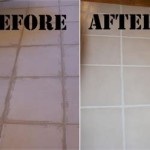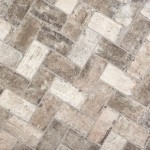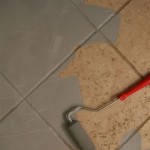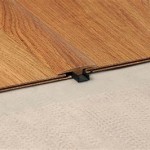How To Install Tile Floor On Concrete Slab
Installing tile flooring on a concrete slab can enhance the aesthetic appeal and durability of any space. This comprehensive guide outlines the necessary steps and considerations for achieving a professional-looking tile installation.
1. Surface Preparation
Proper surface preparation is crucial for successful tile adhesion and longevity. The concrete slab must be clean, level, and free of any debris or contaminants that could interfere with the bonding process. Begin by thoroughly cleaning the concrete surface using a stiff-bristled brush and a suitable cleaning solution, removing any dust, dirt, grease, or old adhesive residue. For stubborn stains or efflorescence, a specialized concrete cleaner or degreaser may be necessary.
Next, assess the slab for levelness. Minor imperfections can be addressed with a self-leveling compound, while significant unevenness might require professional grinding or patching. Any cracks or holes should be repaired using an appropriate concrete patching material, allowing ample drying time before proceeding. Moisture is another critical factor to consider. High moisture content within the concrete can lead to tile failure down the line. A moisture test, using a calcium chloride test or a relative humidity probe, should be performed to ensure that the moisture level is within acceptable limits for the chosen tile and adhesive.
2. Planning and Layout
Before laying any tile, careful planning and layout are essential to minimize waste and achieve a visually appealing result. Begin by measuring the area to be tiled accurately to determine the required number of tiles. Factor in extra tiles for cuts and potential breakage. A dry layout is highly recommended, particularly for complex patterns or designs. This process involves arranging the tiles on the floor without adhesive to visualize the final layout and make any necessary adjustments. Consider the placement of cut tiles, ensuring they are strategically located in less conspicuous areas, such as under cabinets or along edges.
Think about the starting point for the installation. Ideally, start from the center of the room and work outwards to ensure a symmetrical finish. Establish a straight line using a chalk line or laser level to serve as a guide for the initial tile placement. For larger areas, it may be helpful to divide the space into smaller sections using grid lines, simplifying the installation process and maintaining alignment.
3. Applying Thinset Mortar
Thinset mortar acts as the bonding agent between the tile and the concrete slab. Select the appropriate type of thinset based on the specific tile material and environmental conditions. For example, porcelain tiles typically require a modified thinset for enhanced adhesion. Mix the thinset according to the manufacturer’s instructions, achieving a smooth, consistent paste. Avoid mixing too much thinset at once, as it can begin to dry out and become unusable.
Using a notched trowel, apply a layer of thinset to a small section of the floor, covering an area manageable within the thinset’s open time. The size and depth of the notches on the trowel will depend on the size and type of tile being installed. Larger tiles generally require larger notches to ensure full coverage and support. Spread the thinset evenly, holding the trowel at a consistent angle to create uniform ridges. Avoid applying too much thinset, which can squeeze up between the tiles and make grouting difficult.
4. Setting the Tile
Carefully place each tile onto the thinset bed, firmly pressing it into the mortar to ensure a strong bond. Use a slight twisting motion to collapse the ridges and achieve full contact. Maintain consistent spacing between tiles using spacers, which are small plastic crosses or wedges inserted at the corners of each tile. These spacers ensure even grout lines and prevent the tiles from rubbing against each other. Periodically check the alignment of the tiles against the established layout lines and make any necessary adjustments before the thinset sets.
Continue installing tiles in small sections, cleaning any excess thinset that squeezes up between the tiles with a damp sponge before it dries. After the thinset has cured for the recommended time, typically 24 hours, remove the spacers and prepare for grouting.
5. Grouting
Grout fills the spaces between the tiles, providing a finished look and preventing moisture penetration. Select a grout color that complements the tile and the overall design. Mix the grout according to the manufacturer’s instructions to achieve a smooth, workable consistency. Using a grout float, apply the grout diagonally across the tile surface, working it into the joints and ensuring they are completely filled. Remove excess grout from the tile surface with a damp sponge, being careful not to pull the grout out of the joints. After the grout has partially dried, haze can be removed with a clean, damp sponge or a specialized grout haze remover.
Allow the grout to cure for the recommended time, usually a few days, before sealing it with a grout sealer. This will protect the grout from staining and moisture damage, extending its lifespan and maintaining the beauty of the tiled floor. Regular cleaning and maintenance will further enhance the durability and appearance of the installation.

Tiling Over A Ed Concrete Slab Fine Homebuilding
:max_bytes(150000):strip_icc()/can-you-install-tile-directly-on-concrete-1822600-04-458f7bb6c78348c1835cf8054ef36553.jpg?strip=all)
How To Install Tile Over Concrete
How To Tile Onto Concrete Floors Porcelain Super

How To Lay Tile On Concrete With Pictures Wikihow

How To Install Ceramic Tiles On Concrete Floor Tile Installation

Sound Dampening Ceramic Tile Over A Concrete Floor Fine Homebuilding
:max_bytes(150000):strip_icc()/can-you-install-tile-directly-on-concrete-1822600-01-8a89ceab1a274fb8ac81890ab7fc6b1b.jpg?strip=all)
How To Install Tile Over Concrete

How To Lay Floor Tiles On Concrete Welcome The Rubi Tools Blog

How To Install Ceramic Tiles On Concrete Floor Tile Installation
How To Lay Floor Tiles On Concrete Stonesuper
Related Posts








